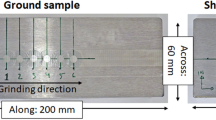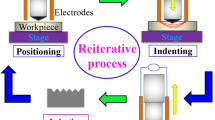Abstract
The electrical discharge machining (EDM) process is mostly used in conditions that complex and intricate shapes need to be machined on very hard metals. However, the process leaves behind some undesirable properties such as high surface roughness, rough topography, high residual tensile stresses, micro-cracks, heat-affected zone (HAZ), and recast layer. This paper investigates the effects of different output parameters on the properties listed above. The input parameters studied include current, pulse-on time, and the type of dielectric; and the material being machined is AISI 1045 steel. Results show that the deionized water improved the output variables in EDM. The use of deionized water as the dielectric, not only improved the machined surfaces’ topography but also lowered the micro-cracks and HAZ thickness. The experiments also show how the pulse-on and current time affect the outcome of EDM machining of AISI 1045 steel.








Similar content being viewed by others
References
HuuPhan Nguyen, Muthuramalingam T, Ngo Ngoc Vu, Nguyen Tuan Quoc (2020) Influence of micro size titanium powder-mixed dielectric medium on surface quality measures in EDM process. Int J Adv Manuf Technol 109(3):797–807. https://doi.org/10.1007/s00170-020-05698-9
Maher I, Sarhan AAD, Hamdi M (2014) Review of improvements in wire electrode properties for longer working time and utilization in wire EDM machining. Int J Adv Manuf Technol 76(1–4):329–351. https://doi.org/10.1007/s00170-014-6243-3
Nayak D, Sahu SN, Mula S (2017) Metallurgical approach towards explaining optimized EDM process parameters for better surface integrity of AISI D2 tool steel. Trans Indian Inst Met 70(5):1183–1191. https://doi.org/10.1007/s12666-016-0910-z
Dhakar K, Chaudhary K, Dvivedi A, Bembalge O (2019) An environment-friendly and sustainable machining method: near-dry EDM. Mater Manuf Process 34(12):1307–1315. https://doi.org/10.1080/10426914.2019.1643471
Camposeco-Negrete C (2019) Prediction and optimization of machining time and surface roughness of AISI O1 Tool steel in wire-cut EDM using robust design and desirability approach. Int J Adv Manuf Technol 103(5–8):2411–2422. https://doi.org/10.1007/s00170-019-03720-3
Al-Amin M, Abdul Rani AM, Abdu Aliyu AA, Abdul Razak MA, Hastuty S, Bryant MG (2020) Powder mixed-EDM for potential biomedical applications: a critical review. Mater Manuf Process 35(16):1789–1811. https://doi.org/10.1080/10426914.2020.1779939
Liu Y, Chang H, Zhang W, Ma F, Sha Z, Zhang S (2018) A simulation study of debris removal process in ultrasonic vibration assisted electrical discharge machining (EDM) of deep holes. Micromachines 9(8):378. https://doi.org/10.3390/mi9080378
Mahajan A, Sidhu SS (2017) Surface modification of metallic biomaterials for enhanced functionality: a review. Mater Technol 33(2):93–105. https://doi.org/10.1080/10667857.2017.1377971
Nair S, Dutta A, Narayanan R, Giridharan A (2019) Investigation on EDM machining of Ti6Al4V with negative polarity brass electrode. Mater Manuf Process 34(16):1824–1831. https://doi.org/10.1080/10426914.2019.1675891
Aich U, Banerjee S (2017) Characterizing topography of EDM generated surface by time series and autocorrelation function. Tribol Int 111:73–90. https://doi.org/10.1016/j.triboint.2017.02.016
Shankar P, Jain VK, Sundararajan T (1997) Analysis of spark profiles during EDM process. Mach Sci Technol 1(2):195–217. https://doi.org/10.1080/10940349708945647
Raj S, Rahul, Sinha H, Shivani R, Das S, Guha S, Aazim, Banik D, Routara BC (2020) Optimization of surface topography of electro- discharge machined super alloy Inconel 825: using TOPSIS integrated with Taguchi philosophy. Mater Today Proc 24:218–224. https://doi.org/10.1016/j.matpr.2020.04.270
Karmiris-Obratański P, Zagórski K, Cieślik J, Papazoglou EL, Markopoulos A (2020) Surface topography of Ti 6Al 4V ELI after High power EDM. Procedia Manuf 47:788–794. https://doi.org/10.1016/j.promfg.2020.04.242
Mahdieh MS (2019) Recast layer and heat-affected zone structure of ultra-fined grained low-carbon steel machined by electrical discharge machining. P I Mech Eng B-J Eng 234(5):933–944. https://doi.org/10.1177/0954405419889202
Paul BK, Sahu SK, Jadam T, Datta S, Dhupal D, Mahapatra SS (2018) Effects of addition of copper powder in the dielectric media (EDM oil) on electro-discharge machining performance of Inconel 718 super alloys. Mater Today Proc 5(9):17618–17626. https://doi.org/10.1016/j.matpr.2018.06.080
Shabgard M, Oliaei SNB, Seyedzavvar M, Najadebrahimi A (2011) Experimental investigation and 3D finite element prediction of the white layer thickness, heat affected zone, and surface roughness in EDM process. J Mech Sci Technol 25(12):3173–3183. https://doi.org/10.1007/s12206-011-0905-y
Khosrozadeh B, Shabgard M (2017) Effects of hybrid electrical discharge machining processes on surface integrity and residual stresses of Ti-6Al-4V titanium alloy. Int J Adv Manuf Technol 93(5–8):1999–2011. https://doi.org/10.1007/s00170-017-0601-x
Guu YH (2005) AFM Surface imaging of AISI D2 tool steel machined by the EDM process. Appl Surf Sci 242(3–4):245–250. https://doi.org/10.1016/j.apsusc.2004.08.028
Muthuramalingam T (2015) Mohan, BA review on influence of electrical process parameters in EDM process. Arch Civ Mech Eng 15(1):87–94. https://doi.org/10.1016/j.ijlmm.2020.08.002
Hourmand M, Farahany S, Sarhan AA, Noordin MY (2015) Investigating the electrical discharge machining (EDM) parameter effects on Al-Mg 2 Si metal matrix composite (MMC) for high material removal rate (MRR) and less EWR–RSM approach. Int J Adv Manuf Technol 77(5):831–838. https://doi.org/10.1007/s00170-014-6491-2
Chakraborty S, Dey V, Ghosh SK (2015) A review on the use of dielectric fluids and their effects in electrical discharge machining characteristics. Precis Eng 2015(40):1–6. https://doi.org/10.1016/j.precisioneng.2014.11.003
Heidari S, Afsari A, Ranaei MA (2020) Increasing wear resistance of copper electrode in electrical discharge machining by using ultra-fine-grained structure. Trans Indian Inst Met 73(11):2901–2910. https://doi.org/10.1007/s12666-020-02091-8
Singh NK, Pandey PM, Singh KK, Sharma MK (2016) Steps towards green manufacturing through EDM process: a review. Cogent Eng 3(1):1272662. https://doi.org/10.1080/23311916.2016.1272662
Zhang Y, Liu Y, Shen Y, Ji R, Li Z, Zheng C (2014) Investigation on the influence of the dielectrics on the material removal characteristics of EDM. J Mater Process Technol 214(5):1052–1061. https://doi.org/10.1016/j.jmatprotec.2013.12.012
Ramasawmy H, Blunt L (2004) Effect of EDM process parameters on 3D surface topography. J Mater Process Technol 148(2):155–164. https://doi.org/10.1016/S0924-0136(03)00652-6
Chen Z, Moverare J, Peng RL, Johansson S (2016) Surface integrity and fatigue performance of Inconel 718 in wire electrical discharge machining. Procedia CIRP 45:307–310. https://doi.org/10.1016/j.procir.2016.02.053
Liu JF, Guo YB, Butler TM, Weaver ML (2016) Crystallography, compositions, and properties of white layer by wire electrical discharge machining of nitinol shape memory alloy. Mater Des 109:1–9. https://doi.org/10.1016/j.matdes.2016.07.063
Masoudi S, Mirabdolahi M, Dayyani M, Jafarian F, Vafadar A, Dorali MR (2018) Development of an intelligent model to optimize heat-affected zone, kerf, and roughness in 309 stainless steel plasma cutting by using experimental results. Mater Manuf Process 34(3):345–356. https://doi.org/10.1080/10426914.2018.1532579
Chen SL, Yan BH, Huang FY (1999) Influence of kerosene and distilled water as dielectrics on the electric discharge machining characteristics of Ti–6A1–4V. J Mater Process Technol 87(1–3):107–111. https://doi.org/10.1016/S0924-0136(98)00340-9
Yildiz Y, Sundaram MM, Rajurkar KP, Altintas A (2015) Correlation of surface roughness and recast layer thickness in electrical discharge machining. P I Mech Eng E-J Pro 231(3):414–424. https://doi.org/10.1177/0954408915600949
Zhang Y, Liu Y, Ji R, Cai B (2011) Study of the recast layer of a surface machined by sinking electrical discharge machining using water-in-oil emulsion as dielectric. Appl Surf Sci 257(14):5989–5997. https://doi.org/10.1016/j.apsusc.2011.01.083
Klocke F, Schneider S, Ehle L, Meyer H, Hensgen L, Klink A (2016) Investigations on surface integrity of heat treated 42CrMo4 (AISI 4140) processed by sinking EDM. Procedia CIRP 42:580–585. https://doi.org/10.1016/j.procir.2016.02.263
Acknowledgements
The authors would like to thank Dr. Ghanbari form University of Kashan for providing the 3D optical microscope in order to surface topography measurement.
Author information
Authors and Affiliations
Contributions
Experiments performed by Mr. Hasan Rahimi and he provided the conception and design of the study. Mr. Soroush Masoudi supervised development of work and performed analysis and interpretation of data, wrote manuscript, and acted as corresponding author. Mr. Majid Rad helped in data interpretation and manuscript evaluation.
Corresponding author
Ethics declarations
Conflict of interest
The authors declare no competing interests.
Additional information
Publisher's note
Springer Nature remains neutral with regard to jurisdictional claims in published maps and institutional affiliations.
Rights and permissions
About this article
Cite this article
Rahimi, H., Masoudi, S. & Tolouei-Rad, M. Experimental investigation of the effect of EDM parameters and dielectric type on the surface integrity and topography. Int J Adv Manuf Technol 118, 1767–1778 (2022). https://doi.org/10.1007/s00170-021-08040-z
Received:
Accepted:
Published:
Issue Date:
DOI: https://doi.org/10.1007/s00170-021-08040-z




